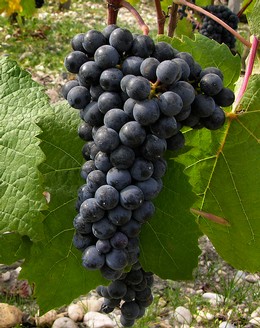14 Jun What is Petit Verdot?
 The wine grape variety Petit Verdot has been getting more attention lately, and for good reasons. I predict that it will be getting a lot more in the years to come, mainly because people are discovering what a great wine it makes, not to mention, the wines keep getting better.
The wine grape variety Petit Verdot has been getting more attention lately, and for good reasons. I predict that it will be getting a lot more in the years to come, mainly because people are discovering what a great wine it makes, not to mention, the wines keep getting better.
A little history on the grape:
It is one of the five classic grape varieties found in the Bordeaux region of France. Because it requires more heat to get ripe than all the others, it is rarely found on the Right Bank but almost exclusively on the Left Bank, where the heat and the well-drained soils allow for more sugar accumulation. Chateau Margaux is one of the more prominent proponents of Petit Verdot, where the vineyards have about 7% of this variety. The former winemaker there, Paul Pontallier, was quick to recognize the vital contribution this grape can make to the wine, including color, structure, and aromatic complexity.
There are no Varietal Petit Verdot’s made in Bordeaux, and I think it is safe to say there are also no Petit Verdot dominant blends. However, like all of the other Bordeaux varieties, Petit Verdot is now spread worldwide from South America to Australia and from Tuscany to Long Island. Found all up and down the west coast of the USA, the variety is generally on the upswing because the climate is getting warmer, allowing more sites to excel with this grape.
The variety has its downsides for sure. In addition to being a late-ripening grape, it tends to be an uneven ripener, requiring several passes during the growing season to eliminate those clusters that are behind. Also, Petit Verdot is not a big producer, partly because of those extra clusters taken off and that both clusters and the berries tend to be small. However, one thing that does help make up for the crop size is that this varietal often has three clusters per shoot instead of the usual two.
Moving from the vineyard to the winery, Petit Verdot has its challenges for winemakers as well. The relatively high acidity combined with the high tannin content can make a wine that is tough to drink. That combination of sourness and astringency can create a battle in your mouth that makes it seem like the wine is winning and your tongue and cheeks are losing. Therefore, winemakers need to be careful not to extract too much tannin from the skins during the fermentation process.
The other allies that winemakers use to tame the wine are blending with softer grapes such as Merlot and Malbec and giving the wine time to soften, both in the barrel and bottle. When picked at full maturity from the right site and made properly, the wine is well worth the wait, and a good Petit Verdot or Petit Verdot-based blend can develop for a decade or more.
At its peak, the wine is big, dark, and complex. What I like most about a Petit Verdot wine is its distinctive floral aromatic quality that resembles the smell of violets. On occasion, it can also mimic lilacs.
While I have been using the Petit Verdot as a blending grape for several decades, it was in 2005 that I decided to take the bold step of making a Petit Verdot-based blend, one of the first-ever made. Giving this wine the time it deserved, it was released in 2010, which was the celebration of my 30th vintage in Washington, and therefore the wine was named Trentenaire, which means “of thirty years” in French. Now, having just released the 2016 Trentenaire, it continues to be many people’s favorite.
Let’s keep the celebration going!
Brian D. Carter, Winemaker


